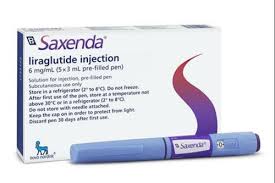Saxenda: A Comprehensive Guide to the Weight Loss Injection
Welcome to our guide to Saxenda, the weight loss injection that has been generating a lot of buzz lately. In this article, we will explain what Saxenda is, how it works, who can benefit from it, how to use it, what are the side effects and risks, and where to buy it. By the end of this guide, you will have a clear understanding of whether Saxenda is the right choice for you and how to optimize its effects.
What is Saxenda?
Saxenda is a brand name for liraglutide, a prescription medication that was originally developed to treat type 2 diabetes. However, it was later found to have weight loss benefits, and in 2014 it was approved by the FDA for use as a weight management medication for adults with a body mass index (BMI) of 30 or higher (obese) or a BMI of 27 or higher (overweight) with at least one weight-related condition, such as high blood pressure, high cholesterol, or type 2 diabetes.
Saxenda is not a magic pill that will make you lose weight effortlessly without any lifestyle changes. Rather, it is an adjunctive therapy that can help you to eat less, feel fuller, and stay motivated to stick to a healthy diet and exercise regimen. Saxenda is meant to be used as part of a comprehensive weight loss program that includes diet, exercise, and behavioral therapy.
How does Saxenda work?
Saxenda works by mimicking the action of a hormone called glucagon-like peptide-1 (GLP-1), which is naturally produced by the body in response to food intake. GLP-1 stimulates the release of insulin, which lowers blood sugar levels, and slows down the emptying of the stomach, which makes you feel fuller for longer. GLP-1 also reduces appetite, cravings, and the desire to eat high-calorie foods.
By injecting Saxenda once a day, usually in the abdomen, thigh, or upper arm, you increase the levels of GLP-1 in your body, which in turn helps to control your hunger and portion size. The dose of Saxenda is gradually increased over several weeks, from 0.6 mg to a maximum of 3 mg, depending on how well you tolerate it and how much weight you need to lose. The duration of Saxenda treatment varies depending on your individual response and goals, but it usually lasts for at least 16 weeks.
Who can benefit from Saxenda?
Saxenda is not for everyone, and it should only be used under the supervision of a healthcare provider who is familiar with its risks and benefits. Saxenda is contraindicated in people who have a personal or family history of medullary thyroid carcinoma (MTC) or multiple endocrine neoplasia syndrome type 2 (MEN 2), as Saxenda may increase the risk of developing these rare but serious types of thyroid cancer. Saxenda is also not recommended for pregnant or breastfeeding women, as its safety in these populations has not been established.
However, if you are an adult who is struggling with obesity or overweight and you have tried other weight loss methods without success, Saxenda may be an effective option for you. Saxenda may also be useful if you have comorbidities that are aggravated by excess weight, such as type 2 diabetes, high blood pressure, or sleep apnea. Saxenda is not a cosmetic drug or a shortcut to weight loss, but rather a tool that can help you to achieve sustainable and long-lasting results if used as part of a holistic approach to health and wellness.
How to use Saxenda?
Using Saxenda requires some preparation and guidance from
your healthcare provider. Before starting Saxenda, you should inform your doctor about your medical history, current medications, allergies, and lifestyle habits, such as smoking and alcohol consumption. Your doctor will also measure your BMI, blood pressure, and other vital signs, and may order some lab tests to rule out any underlying conditions that may affect the safety or efficacy of Saxenda.
Once you have been cleared for Saxenda use, your doctor will provide you with a prescription and a detailed instruction on how to use the injection pen. Saxenda is self-administered subcutaneously, meaning that you inject it under your skin using a pre-filled pen that contains the medication and a needle. The injection should be taken once a day, at the same time, preferably before your first meal of the day. Saxenda should be stored in the refrigerator, and the pen should be discarded after 30 days of use, even if there is some solution left in it.
It is important to follow the dosing schedule and the injection technique that your doctor has prescribed, as well as to monitor your weight, blood sugar, and any side effects that you may experience. Your doctor may adjust your dose of Saxenda based on your response, and may also recommend some lifestyle changes, such as a low-calorie diet, regular physical activity, and stress management, to maximize the benefits of Saxenda and to promote overall health.
What are the side effects and risks of Saxenda?
Like any medication, Saxenda has some potential side effects and risks that you should be aware of before using it. The most common side effects of Saxenda are nausea, vomiting, diarrhea, constipation, stomach pain, headache, dizziness, and fatigue. These side effects usually occur in the first few weeks of treatment, and tend to subside as your body adjusts to Saxenda.
However, if these side effects persist or worsen, or if you experience more serious side effects, such as pancreatitis, gallbladder disease, kidney problems, or allergic reactions, you should stop using Saxenda immediately and seek medical attention. Saxenda may also interact with some medications, such as insulin, sulfonylureas, and other GLP-1 agonists, so you should inform your doctor about all the medications and supplements that you are taking before using Saxenda.
Moreover, Saxenda may increase the risk of developing thyroid cancer or pancreatitis, especially in people who have a history of these conditions or who have a family history of these conditions. Therefore, you should undergo regular checkups and screenings while using Saxenda, and report any abnormal symptoms or changes to your doctor.
Where to buy Saxenda?
Saxenda is a prescription medication that can only be purchased from a licensed pharmacy or an online pharmacy that requires a valid prescription. Saxenda is not available over-the-counter or without a prescription, as it requires close medical supervision and monitoring. Therefore, if you are interested in using Saxenda, you should consult with a healthcare provider who is authorized to prescribe Saxenda, and who can guide you through the entire process, from the initial evaluation to the ongoing management.
Conclusion:
In summary, Saxenda is a weight loss injection that can be an effective tool for adults with obesity or overweight who have failed to lose weight through other means. Saxenda works by mimicking a hormone called GLP-1, which regulates hunger, satiety, and blood sugar. Saxenda should be used as part of a comprehensive weight loss program that includes diet, exercise, and behavioral therapy, and under the supervision of a healthcare provider who is familiar with its risks and benefits. Saxenda has some potential side effects and risks that should be discussed with your doctor before using it.




